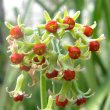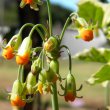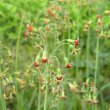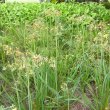| Botanical Name |
|
| Family |
Alliaceae - The onion family. |
| Pronunciation |
|
| Common Name(s) |
English: Wild garlic; Woodland Garlic
IsiXhosa: iVimba'mpunzi; Umwelela
IsiZulu: umSikwa; Ishaladilezinyoka; Umwelela
|
| Plant Group |
- Bulb / Corm / Rhizome / Tuber / Epigeal bulb Bulbs: are made up of fleshy scales as in an onion
Corm: a short, swollen, underground stem that is hard and not fleshy as in a gladiolus
Tuber: a solid, fleshy, underground, storage organ as in a potato
Rhizome: an underground, horizontal, swollen stem at the base of the plant as in an iris
Epigeal bulb: bulbs that rest above the ground with only the roots anchoring the plant to the earth as in albuca
- Veld Flower Small veld flowers of interest, rather than for their usefulness in the garden. Some of these plants have garden potential, particularly for less formal garden situations.
|
| Plant Size |
- Medium
| Tree | 10m to 16m |
| Shrub | 1m to 2m |
| Perennial/ground cover | 40cm to 60cm |
| Bulb | 40cm to 60cm |
| Succulent | 40cm to 60cm |
- Small to Medium
| Tree | 8m to 15m |
| Shrub | 75cm to 1m |
| Perennial/ground cover | 20cm to 40cm |
| Bulb | 30cm to 40cm |
| Succulent | 20cm to 40cm |
|
| Position |
- Light or Dappled Shade Found below trees with sparse, open foliage. Ideal for the protection of herbaceous plants.
- Partial Shade The area is in shade for part of the day and in full sun for part of the day.
- Sun The area is in full sun for all or most of the day, all year round.
|
| General Information |
- Deciduous to Semi-deciduous In warmer areas a deciduous plant may not lose its leaves during winter at all, or may lose its leaves for a very brief period, or may only lose part of its foliage.
- Drought Tolerance: High The plant is well adapted to arid conditions; it can survive long periods of drought and high temperatures without extra water.
- Fragrant / Aromatic These plants posses a strong, usually pleasant odour.
- Frost: Hardy The plant can withstand freezing temperatures or frost without artificial protection.
- Water Wise Plant species originating from low rainfall regions that require less water to survive and thrive than other plant species.
|
| Specific Information |
The flowers of Tulbaghia alliacea are sweetly scented, especially at night. Although the flowers are attractive, they are not showy. However, it is useful and attractive in the wild garden and in random open spaces needing a filler. The specimens in my garden are in a moist area and have been evergreen thus far. They do not seem to make offsets as readily as Tulbaghia violacea. I find their nodding little red and yellow flowers are a pleasing sight.
|
| Ad Break |
|
| Flowers |
| Description |
a loose head of small roundish flowers on a long stem
|
| Season |
- Summer Plants will seldom bloom for the entire season as given in the list, but should flower during a period within these parameters.
|
| Colour |
|
| Growth Rate |
- Moderate Specifying growth rate can be very misleading as there is considerable variation of growth rate depending on type and species of plant, available water, supplementary feeding, mulching and general care, as well as the plants suitability and adaptability to the garden environment.
|
| Plant Uses |
- Attracts bees, butterflies or other insects This plant attracts insects which can be food for birds or other creatures in your garden.
- Cut Flowers Plants that provide flowers suitable for ornamental uses.
- Filler Either a fast growing tree or shrub used temporarily to fill in an area while the permanent plants grow to a desired size, or a plant used to fill gaps in borders or beds.
- Wild Garden An indigenous garden planted for the benefit of wildlife and birds. Provides food, water, a variety of mini-biomes and no poisonous chemicals are used.
|
| Distribution and Habitat |
throughout the Western and Eastern Cape, in grasslands
|
| Planting Suggestions |
These tulbaghia require well drained soil with a little compost. They can be left to multiply for a few years before lifting and separating which should be done after seeding or when the leaves die down.
|
| Medicinal Uses |
Stomach ailments; a bulb infusion taken orally to treat fever; remedy for tuberculosis and influenza; as an antihypertensive or to expel intestinal worms; as a medicated bath to treat paralysis, rheumatism and reduce fever.The leaves are used as a vegetable and relish.
|
| Ad Break |
|









Discuss this plant
Share knowledge, ask a question or give an experience.